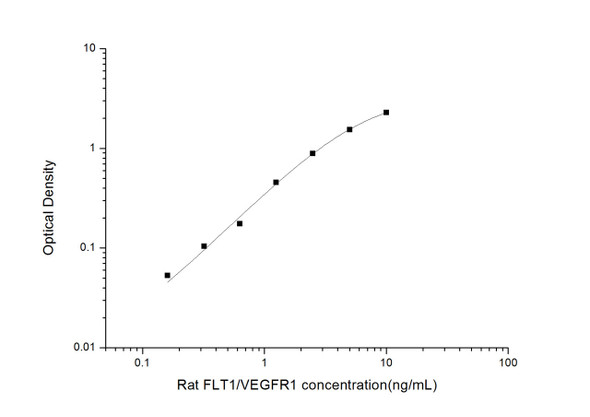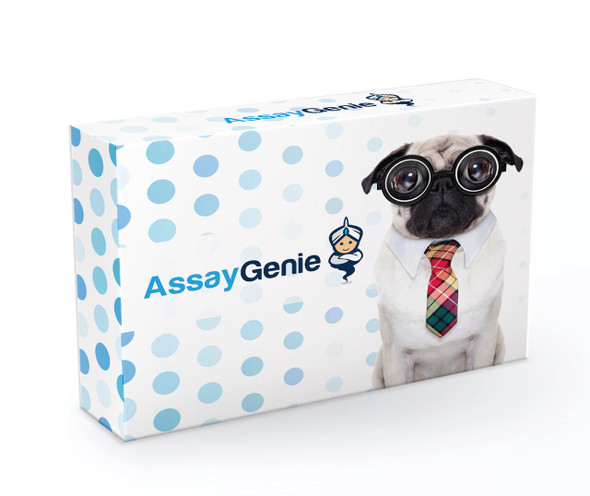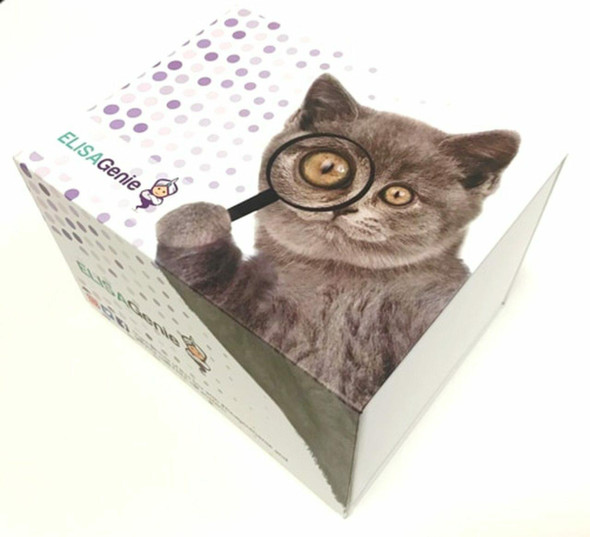Description
Mouse Vascular endothelial growth factor receptor 1 (Flt1) ELISA Kit
The Mouse Vascular Endothelial Growth Factor Receptor 1 (FLT1) ELISA Kit is a powerful tool for the accurate measurement of FLT1 levels in mouse serum, plasma, and cell culture supernatants. This kit offers exceptional sensitivity and specificity, ensuring precise and reproducible results for a variety of research applications.FLT1 is a key factor in angiogenesis, playing a critical role in blood vessel formation and cellular proliferation. This protein is implicated in a range of health conditions including cancer, cardiovascular diseases, and neurodegenerative disorders, highlighting its importance as a biomarker for investigating these diseases and developing potential treatments.
With the Mouse Vascular Endothelial Growth Factor Receptor 1 (FLT1) ELISA Kit, researchers can confidently study the role of FLT1 in various physiological and pathological processes, advancing our understanding of angiogenesis and its implications in disease development.
| Product Name: | Mouse Vascular endothelial growth factor receptor 1 (Flt1) ELISA Kit |
| SKU: | MOEB0140 |
| Size: | 96T |
| Target: | Mouse Vascular endothelial growth factor receptor 1 (Flt1) |
| Synonyms: | Embryonic receptor kinase 2, Fms-like tyrosine kinase 1, Tyrosine-protein kinase receptor FLT, FLT-1, VEGFR-1, Emrk2, Flt, Vegfr1 |
| Assay Type: | Sandwich |
| Detection Method: | ELISA |
| Reactivity: | Mouse |
| Detection Range: | 0.156-10ng/mL |
| Sensitivity: | 0.078ng/mL |
| Intra CV: | 7.7% | ||||||||||||||||||||
| Inter CV: | 9.7% | ||||||||||||||||||||
| Linearity: |
| ||||||||||||||||||||
| Recovery: |
| ||||||||||||||||||||
| Function: | Tyrosine-protein kinase that acts as a cell-surface receptor for VEGFA, VEGFB and PGF, and plays an essential role in the development of embryonic vasculature, the regulation of angiogenesis, cell survival, cell migration, macrophage function, chemotaxis, and cancer cell invasion. May play an essential role as a negative regulator of embryonic angiogenesis by inhibiting excessive proliferation of endothelial cells. Can promote endothelial cell proliferation, survival and angiogenesis in adulthood. Its function in promoting cell proliferation seems to be cell-type specific. Promotes PGF-mediated proliferation of endothelial cells, and proliferation of some types of cancer cells, but does not promote proliferation of normal fibroblasts. Has very high affinity for VEGFA and relatively low protein kinase activity; may function as a negative regulator of VEGFA signaling by limiting the amount of free VEGFA and preventing its binding to KDR. Modulates KDR signaling by forming heterodimers with KDR. Ligand binding leads to the activation of several signaling cascades. Activation of PLCG leads to the production of the cellular signaling molecules diacylglycerol and inositol 1,4,5-trisphosphate and the activation of protein kinase C. Mediates phosphorylation of PIK3R1, the regulatory subunit of phosphatidylinositol 3-kinase, leading to the activation of phosphatidylinositol kinase and the downstream signaling pathway. Mediates activation of MAPK1/ERK2, MAPK3/ERK1 and the MAP kinase signaling pathway, as well as of the AKT1 signaling pathway. Phosphorylates SRC, YES1 and PLCG, and may also phosphorylate CBL. Promotes phosphorylation of AKT1 and PTK2/FAK1. |
| Uniprot: | P35969 |
| Sample Type: | Serum, plasma, tissue homogenates, cell culture supernates and other biological fluids |
| Specificity: | Natural and recombinant mouse Vascular endothelial growth factor receptor 1 |
| Sub Unit: | Interacts with VEGFA, VEGFB and PGF. Monomer in the absence of bound VEGFA, VEGFB or PGF. Homodimer in the presence of bound VEGFA, VEGFB and PGF. Can also form a heterodimer with KDR. Interacts (tyrosine phosphorylated) with CBL, CRK, GRB2, NCK1, PIK3R1, PLCG, PSEN1 and PTPN11. Probably interacts with PTPRB. Interacts with RACK1. Identified in a complex with CBL and CD2AP. |
| Research Area: | Cardiovascular |
| Subcellular Location: | Cell membrane Single-pass type I membrane protein Endosome Autophosphorylation promotes ubiquitination and endocytosis. |
| Storage: | Please see kit components below for exact storage details |
| Note: | For research use only |
| UniProt Protein Function: | VEGFR1: a receptor tyrosine kinase of the VEGFR family. Receptor for VEGF, VEGFB and PGF. The VEGF-kinase ligand/receptor signaling system plays a key role in vascular development and regulation of vascular permeability. Two splice variant isoforms have been described. Isoform SFlt1 may have an inhibitory role in angiogenesis. |
| UniProt Protein Details: | Protein type:Membrane protein, integral; Protein kinase, TK; Kinase, protein; EC 2.7.10.1; Protein kinase, tyrosine (receptor); TK group; VEGFR family Cellular Component: focal adhesion; membrane; integral to plasma membrane; integral to membrane; plasma membrane; receptor complex; endosome Molecular Function:transferase activity; identical protein binding; vascular endothelial growth factor receptor activity; growth factor binding; protein-tyrosine kinase activity; transferase activity, transferring phosphorus-containing groups; nucleotide binding; transmembrane receptor protein tyrosine kinase activity; kinase activity; ATP binding; protein kinase activity Biological Process: cell migration; peptidyl-tyrosine phosphorylation; protein amino acid autophosphorylation; multicellular organismal development; positive regulation of phosphoinositide 3-kinase activity; chemotaxis; protein amino acid phosphorylation; positive regulation of vascular endothelial growth factor receptor signaling pathway; positive regulation of phosphoinositide 3-kinase cascade; patterning of blood vessels; positive regulation of MAP kinase activity; monocyte chemotaxis; positive regulation of angiogenesis; positive regulation of MAPKKK cascade; response to hypoxia; blood vessel morphogenesis; angiogenesis; sprouting angiogenesis; embryonic morphogenesis; cell differentiation; vascular endothelial growth factor receptor signaling pathway; phosphorylation; transmembrane receptor protein tyrosine kinase signaling pathway; positive regulation of cell migration |
| UniProt Code: | P35969 |
| NCBI GenInfo Identifier: | 549319 |
| NCBI Gene ID: | 14254 |
| NCBI Accession: | P35969.1 |
| UniProt Secondary Accession: | P35969,O55094, Q61517, |
| UniProt Related Accession: | P35969 |
| Molecular Weight: | 149,876 Da |
| NCBI Full Name: | Vascular endothelial growth factor receptor 1 |
| NCBI Synonym Full Names: | FMS-like tyrosine kinase 1 |
| NCBI Official Symbol: | Flt1 |
| NCBI Official Synonym Symbols: | Flt-1; sFlt1; VEGFR1; VEGFR-1; AI323757 |
| NCBI Protein Information: | vascular endothelial growth factor receptor 1; embryonic receptor kinase 2; tyrosine-protein kinase receptor FLT; vascular permeability factor receptor; vascular endothelial growth factor receptor-1 |
| UniProt Protein Name: | Vascular endothelial growth factor receptor 1 |
| UniProt Synonym Protein Names: | Embryonic receptor kinase 2; Fms-like tyrosine kinase 1; FLT-1; Tyrosine-protein kinase receptor FLT |
| Protein Family: | Vascular endothelial growth factor receptor |
| UniProt Gene Name: | Flt1 |
| UniProt Entry Name: | VGFR1_MOUSE |
| Component | Quantity (96 Assays) | Storage |
| ELISA Microplate (Dismountable) | 8×12 strips | -20°C |
| Lyophilized Standard | 2 | -20°C |
| Sample Diluent | 20ml | -20°C |
| Assay Diluent A | 10mL | -20°C |
| Assay Diluent B | 10mL | -20°C |
| Detection Reagent A | 120µL | -20°C |
| Detection Reagent B | 120µL | -20°C |
| Wash Buffer | 30mL | 4°C |
| Substrate | 10mL | 4°C |
| Stop Solution | 10mL | 4°C |
| Plate Sealer | 5 | - |
Other materials and equipment required:
- Microplate reader with 450 nm wavelength filter
- Multichannel Pipette, Pipette, microcentrifuge tubes and disposable pipette tips
- Incubator
- Deionized or distilled water
- Absorbent paper
- Buffer resevoir
*Note: The below protocol is a sample protocol. Protocols are specific to each batch/lot. For the correct instructions please follow the protocol included in your kit.
Allow all reagents to reach room temperature (Please do not dissolve the reagents at 37°C directly). All the reagents should be mixed thoroughly by gently swirling before pipetting. Avoid foaming. Keep appropriate numbers of strips for 1 experiment and remove extra strips from microtiter plate. Removed strips should be resealed and stored at -20°C until the kits expiry date. Prepare all reagents, working standards and samples as directed in the previous sections. Please predict the concentration before assaying. If values for these are not within the range of the standard curve, users must determine the optimal sample dilutions for their experiments. We recommend running all samples in duplicate.
| Step | |
| 1. | Add Sample: Add 100µL of Standard, Blank, or Sample per well. The blank well is added with Sample diluent. Solutions are added to the bottom of micro ELISA plate well, avoid inside wall touching and foaming as possible. Mix it gently. Cover the plate with sealer we provided. Incubate for 120 minutes at 37°C. |
| 2. | Remove the liquid from each well, don't wash. Add 100µL of Detection Reagent A working solution to each well. Cover with the Plate sealer. Gently tap the plate to ensure thorough mixing. Incubate for 1 hour at 37°C. Note: if Detection Reagent A appears cloudy warm to room temperature until solution is uniform. |
| 3. | Aspirate each well and wash, repeating the process three times. Wash by filling each well with Wash Buffer (approximately 400µL) (a squirt bottle, multi-channel pipette,manifold dispenser or automated washer are needed). Complete removal of liquid at each step is essential. After the last wash, completely remove remaining Wash Buffer by aspirating or decanting. Invert the plate and pat it against thick clean absorbent paper. |
| 4. | Add 100µL of Detection Reagent B working solution to each well. Cover with the Plate sealer. Incubate for 60 minutes at 37°C. |
| 5. | Repeat the wash process for five times as conducted in step 3. |
| 6. | Add 90µL of Substrate Solution to each well. Cover with a new Plate sealer and incubate for 10-20 minutes at 37°C. Protect the plate from light. The reaction time can be shortened or extended according to the actual color change, but this should not exceed more than 30 minutes. When apparent gradient appears in standard wells, user should terminatethe reaction. |
| 7. | Add 50µL of Stop Solution to each well. If color change does not appear uniform, gently tap the plate to ensure thorough mixing. |
| 8. | Determine the optical density (OD value) of each well at once, using a micro-plate reader set to 450 nm. User should open the micro-plate reader in advance, preheat the instrument, and set the testing parameters. |
| 9. | After experiment, store all reagents according to the specified storage temperature respectively until their expiry. |
When carrying out an ELISA assay it is important to prepare your samples in order to achieve the best possible results. Below we have a list of procedures for the preparation of samples for different sample types.
| Sample Type | Protocol |
| Serum | If using serum separator tubes, allow samples to clot for 30 minutes at room temperature. Centrifuge for 10 minutes at 1,000x g. Collect the serum fraction and assay promptly or aliquot and store the samples at -80°C. Avoid multiple freeze-thaw cycles. If serum separator tubes are not being used, allow samples to clot overnight at 2-8°C. Centrifuge for 10 minutes at 1,000x g. Remove serum and assay promptly or aliquot and store the samples at -80°C. Avoid multiple freeze-thaw cycles. |
| Plasma | Collect plasma using EDTA or heparin as an anticoagulant. Centrifuge samples at 4°C for 15 mins at 1000 × g within 30 mins of collection. Collect the plasma fraction and assay promptly or aliquot and store the samples at -80°C. Avoid multiple freeze-thaw cycles. Note: Over haemolysed samples are not suitable for use with this kit. |
| Urine & Cerebrospinal Fluid | Collect the urine (mid-stream) in a sterile container, centrifuge for 20 mins at 2000-3000 rpm. Remove supernatant and assay immediately. If any precipitation is detected, repeat the centrifugation step. A similar protocol can be used for cerebrospinal fluid. |
| Cell culture supernatant | Collect the cell culture media by pipette, followed by centrifugation at 4°C for 20 mins at 1500 rpm. Collect the clear supernatant and assay immediately. |
| Cell lysates | Solubilize cells in lysis buffer and allow to sit on ice for 30 minutes. Centrifuge tubes at 14,000 x g for 5 minutes to remove insoluble material. Aliquot the supernatant into a new tube and discard the remaining whole cell extract. Quantify total protein concentration using a total protein assay. Assay immediately or aliquot and store at ≤ -20 °C. |
| Tissue homogenates | The preparation of tissue homogenates will vary depending upon tissue type. Rinse tissue with 1X PBS to remove excess blood & homogenize in 20ml of 1X PBS (including protease inhibitors) and store overnight at ≤ -20°C. Two freeze-thaw cycles are required to break the cell membranes. To further disrupt the cell membranes you can sonicate the samples. Centrifuge homogenates for 5 mins at 5000xg. Remove the supernatant and assay immediately or aliquot and store at -20°C or -80°C. |
| Tissue lysates | Rinse tissue with PBS, cut into 1-2 mm pieces, and homogenize with a tissue homogenizer in PBS. Add an equal volume of RIPA buffer containing protease inhibitors and lyse tissues at room temperature for 30 minutes with gentle agitation. Centrifuge to remove debris. Quantify total protein concentration using a total protein assay. Assay immediately or aliquot and store at ≤ -20 °C. |
| Breast Milk | Collect milk samples and centrifuge at 10,000 x g for 60 min at 4°C. Aliquot the supernatant and assay. For long term use, store samples at -80°C. Minimize freeze/thaw cycles. |









